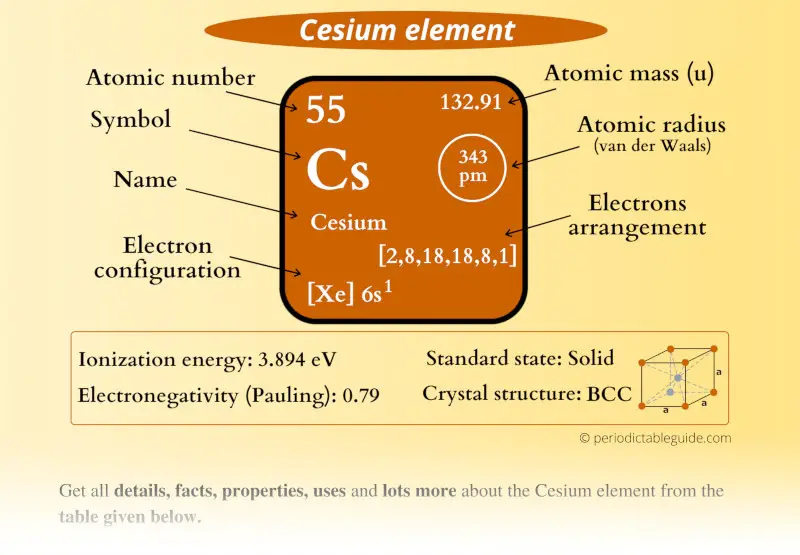
This is a SUPER easy guide on Cesium element.
In fact, the table mentioned below is the perfect information box (Which gives you every single detail about the Cesium element in Periodic table.)
So if you want to know anything about Cesium element, then this guide is for you.
Let’s dive right into it!
Cesium Element (Cs) Information
| Appearance | 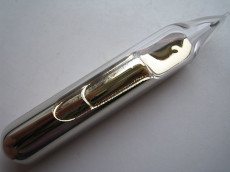 Silvery pale gold |
| State (at STP) | Solid |
| Position in Periodic table | 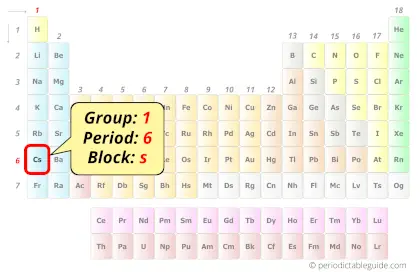 Group: 1, Period: 6, Block: s |
| Category | 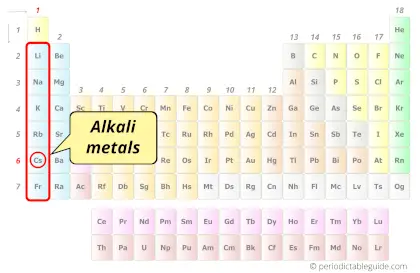 Alkali metals |
| Atomic number or Protons | 55 |
| Neutrons | 78 |
| Electrons | 55 |
| Symbol | Cs |
| Atomic mass | 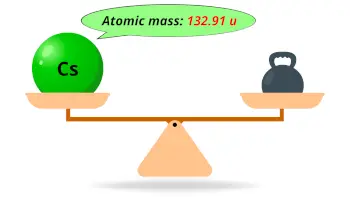 132.91 u |
| Electrons arrangement or Bohr model | 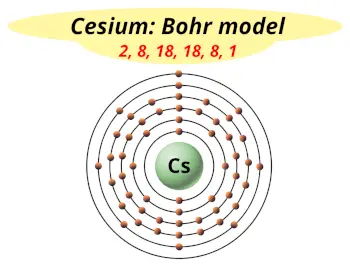 2, 8, 18, 18, 8, 1 |
| Electronic configuration | [Xe] 6s1 |
| Atomic radius | 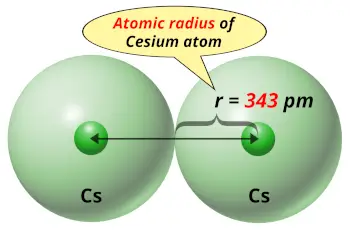 343 picometers (van der Waals radius) |
| Valence electrons | 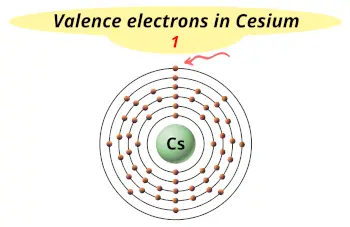 1 |
| 1st Ionization energy | 3.894 eV |
| Electronegativity | 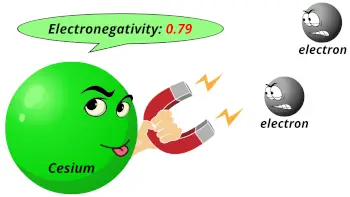 0.79 (Pauling scale) |
| Crystal structure | 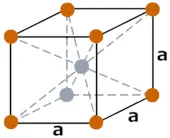 BCC (Body centered cubic) |
| Melting point | 301.7 K or 28.5 °C or 83.3 °F |
| Boiling point | 944 K or 671 °C or 1240 °F |
| Density | 1.88 g/cm3 |
| Main isotope | 133Cs |
| Who discovered Cesium and when? |  Gustav Kirchhoff and Robert Bunsen (in 1860) |
| CAS number | 7440-46-2 |
Cesium in Periodic table
Cesium element (also spelled as caesium) is in group 1 and period 6 of the Periodic table. Cesium is the s-block element and it belongs to alkali metals group.
| H | He | ||||||||||||||||
| Li | Be | B | C | N | O | F | Ne | ||||||||||
| Na | Mg | Al | Si | P | S | Cl | Ar | ||||||||||
| K | Ca | Sc | Ti | V | Cr | Mn | Fe | Co | Ni | Cu | Zn | Ga | Ge | As | Se | Br | Kr |
| Rb | Sr | Y | Zr | Nb | Mo | Tc | Ru | Rh | Pd | Ag | Cd | In | Sn | Sb | Te | I | Xe |
| Cs | Ba | La* | Hf | Ta | W | Re | Os | Ir | Pt | Au | Hg | Tl | Pb | Bi | Po | At | Rn |
| Fr | Ra | Ac** | Rf | Db | Sg | Bh | Hs | Mt | Ds | Rg | Cn | Nh | Fl | Mc | Lv | Ts | Og |
| *Ce | Pr | Nd | Pm | Sm | Eu | Gd | Tb | Dy | Ho | Er | Tm | Yb | Lu | ||||
| **Th | Pa | U | Np | Pu | Am | Cm | Bk | Cf | Es | Fm | Md | No | Lr |
←Move to: Xenon (Xe) element – Periodic Table
→Move to: Barium (Ba) element – Periodic Table
Why is Caesium in Group 1?
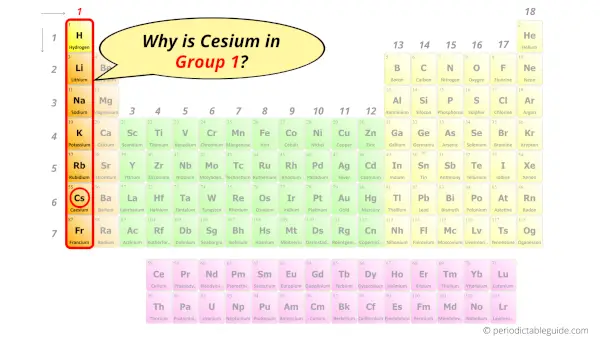
Do you know, how many electrons can be accommodated in the first shell, second shell, third shell, fourth shell, etc…?
Here is the table showing the capacity of orbits to hold electrons.
Number of electrons in shells.
| Orbit / Shell (n) | Maximum no. of electrons this orbit can hold (2 × n2) |
| K shell, n = 1 | 2 × 1² = 2 |
| L shell, n = 2 | 2 × 2² = 8 |
| M shell, n = 3 | 2 × 3² = 18 |
| N shell, n = 4 | 2 × 4² = 32 |
| . . . | . . . |
Thus,
- 1st shell can hold 2 electrons.
- 2nd shell can hold 8 electrons.
- 3rd shell can hold 18 electrons.
- 4th shell can hold 32 electrons, and so on.
Now the atomic number of cesium (Cs) is 55.
Hence the electron arrangement in caesium is 2, 8, 18, 18, 8, 1.
This electron arrangement indicates that the outermost orbit (i.e orbit number 6) of a caesium atom has 1 electrons.
Hence, it lies in group 1.
Why is Cesium in Period 6?
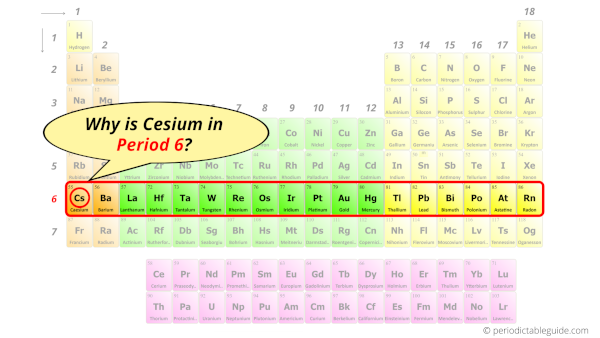
Let me ask you a question.
How many shells does cesium have?
It’s 6. Right?
You have already seen the bohr model of cesium atom in the above table.
From the Bohr model, it can be found that the number of orbits or shells in cesium is 6. Hence, as cesium has 6 orbits, it lies in period 6 of the Periodic table.
Why is Cesium in s-block?
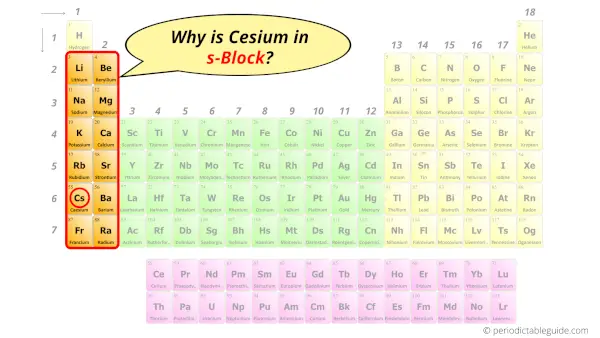
Before knowing this reason, first of all I want to ask you a simple question.
How can you determine the blocks-wise position of elements?
The simple answer: The elements will lie in the s, p, d or f block will completely depend upon the subshell in which the last electron will enter.
For example; the electron configuration of cesium is [Xe] 6s1.
So the last electron of cesium enters the s-subshell or s-orbital.
Hence, cesium is the s-block element.
7 Interesting facts about Indium
Interesting facts about indium element are mentioned below.
- The name cesium was derived from the Latin word “caesius”, which means sky blue.
- Cesium was the first element that was discovered with a spectroscope.
- The amount of cesium present in the earth’s crust is approximately 3 ppm by weight.
- Cesium is the 50th most abundant element found from the earth’s crust. [1]
- The density of cesium is twice that of the density of water.
- Cesium was discovered by Gustav Kirchhoff and Robert Bunsen (in 1860).
- Pollucite (which is the ore of cesium) has the largest deposits at Bernic lake in Canada.
Properties of Indium
The physical and chemical properties of indium element are mentioned below.
Physical properties of Indium
Physical properties of indium are mentioned below.
- Cesium is a solid metal having a Silvery pale gold appearance.
- Cesium is a soft metal at room temperature (it is soft like wax).
- Cesium is a ductile metal which can be drawn into thin wires.
- The melting point of cesium is 28.5 °C and its boiling point is 671 °C.
- The atomic mass of cesium is 132.91 u and its density is 1.88 g/cm3.
- The crystal structure of cesium is FCC (face centered cubic).
- Cesium has many isotopes, but out of those isotopes, the isotope 133Cs is the most abundant one (almost 100%).
Chemical properties of Indium
Chemical properties of indium are mentioned below.
- Cesium is a highly reactive chemical element and because of this, it is not found in its free state. But it is always found as a compound with other elements.
- Cesium is such a reactive metal that is required to be kept under kerosene or a mineral oil.
- Cesium has only 1 electron in its outermost orbit and it loses this electron to become stable during a chemical reaction.
- Cesium reacts violently with water, phosphorus, sulfur as well as halogens of the periodic table.
- When cesium reacts with water, it forms cesium hydroxide.
- The first ionization energy of caesium is 3.894 eV.
- The electronegativity of cesium is 0.79 on the Pauling scale.
Uses of Indium
Uses of indium are mentioned below.
- As cesium is reactive to oxygen, it was used in vacuum tubes to remove the oxygen gas.
- Cesium is used as a catalyst in the hydrogenation of organic compounds. [2]
- Cesium is used in photoelectric cells as well as photomultiplier tubes.
- The compounds of cesium are used as drilling fluids in petroleum industries.
- Cesium compounds are also used in making special optical glasses.
Explore our New Interactive Periodic Table (with Rotating Bohr Models and More)

Details about this Periodic table:
- Access detailed info on all elements: atomic mass, electron configurations, charges, and more.
- View rotating Bohr models for all 118 elements.
- Get a free HD image of the Periodic Table.
Note: For future use, bookmark this Periodic table or visit “PeriodicTableGuide.com”
External resources:
- P. (n.d.). Cesium | Cs (Element) – PubChem. Cesium | Cs (Element) – PubChem. https://pubchem.ncbi.nlm.nih.gov/element/Cesium
- It’s Elemental – The Element Cesium. (n.d.). It’s Elemental – the Element Cesium. https://education.jlab.org/itselemental/ele055.html
- Caesium – Wikipedia. (2010, September 26). Caesium – Wikipedia. https://en.wikipedia.org/wiki/Caesium
- Caesium – Element information, properties and uses | Periodic Table. (n.d.). Caesium – Element Information, Properties and Uses | Periodic Table. https://www.rsc.org/periodic-table/element/55/caesium
- Periodic Table of Elements: Los Alamos National Laboratory. (n.d.). Periodic Table of Elements: Los Alamos National Laboratory. https://periodic.lanl.gov/55.shtml
- C&EN: IT’S ELEMENTAL: THE PERIODIC TABLE – CESIUM. (n.d.). C&EN: IT’S ELEMENTAL: THE PERIODIC TABLE – CESIUM. https://pubsapp.acs.org/cen/80th/cesium.html?
